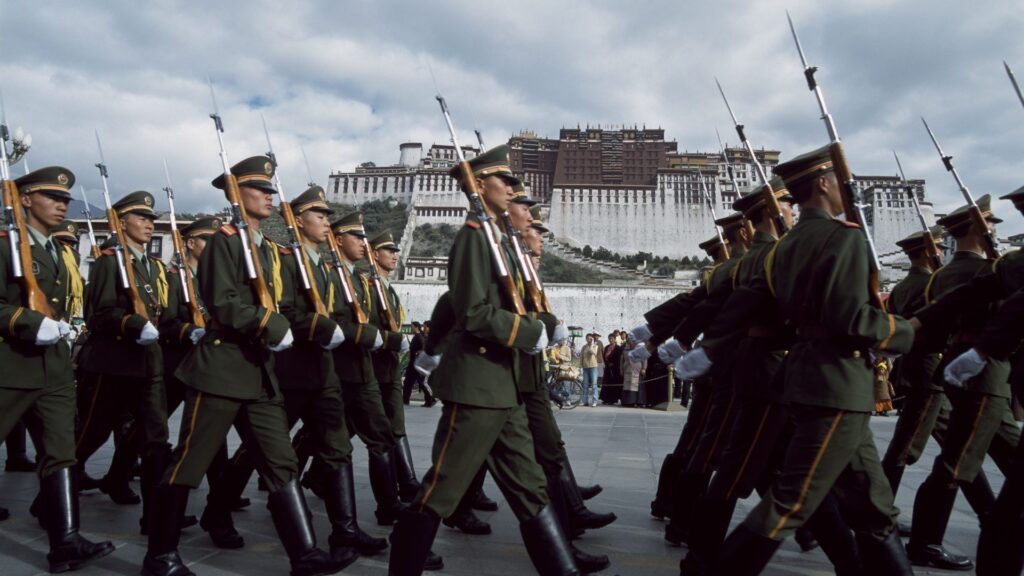In February, Indian media attacked opposition leader Rahul Gandhi for using a Chinese drone while talking about drone warfare. Gandhi expressed concern over India’s drone-manufacturing capabilities, especially against hostile powers like China. Significantly, it was Gandhi’s use of a Chinese drone in a demonstrative video released by the Indian National Congress that was heavily publicised in the media, and not what Gandhi had to say about the extremely disruptive nature of drone warfare.
In a social media post, Rahul Gandhi had said, “Drones have revolutionised warfare, combining batteries, motors and optics to manoeuvre and communicate on the battlefield in unprecedented ways. But drones are not just one technology— they are bottom-up innovations produced by a strong industrial system.”
Gandhi’s comments are in line with emerging strategic thinking on the subject. Experts in India and around the world have long anticipated the changing nature of warfare in the 21st century, where modern communications and small, unmanned weapons and surveillance systems are increasingly shaping the battlefield.
In a New York Times report from March 3, Ukrainian officials were quoted as saying drones “now kill more soldiers and destroy more armored vehicles in Ukraine than all traditional weapons of war combined.” The claim is backed up by figures from a UN Human Rights Monitoring Mission report from February, which stated that in January of this year short-range drones caused more casualties than any other weapon in Ukraine.
In the New York Times report, Ukraine’s drone force commander, Colonel Vadem Sukharevsky, said Ukraine is now pursuing a “robots first” military strategy.
In 2024 alone, Ukraine is believed to have manufactured over a million first-person-view (FPV) drones. Russia is reported to be manufacturing over 4,000 a day. Both nations plan to ramp up drone production sizeably.
In an assessment of China’s drone capabilities, the US Department of Defence noted that in addition to pre-existing surveillance and reconnaissance roles, the Chinese People’s Liberation Army (PLA) is also making use of large drones for other operations, such as “anti-submarine roles, firefighting, and weather modification.”
On the introduction of drones to combat operations, the report published by the US DoD said,”PRC developers are demonstrating an interest in additional growth beyond ISR [Intelligence, Surveillance & Reconnaissance] and [electronic warfare] into air-to-air and air-to-ground combat, with substantial development efforts to produce swarming capability for operational applications.”
China is also working on employing AI for target acquisition and other military applications for autonomous vehicles.
“To actualize the level of AI integration that the PLA is envisioning, Beijing recognizes the need to leverage developments from across its commercial and academic sectors. By 2030, the PLA expects to field a range of ‘algorithmic warfare’ and ‘network-centric warfare’ capabilities,” the report said.
The Chinese military’s objective in drone and AI research is the development of “a future multi-domain kill-web designed to target penetrating counter-air by coordinating across aircraft, sensors, and missiles.” On the ground, this emergent strategy will bear little resemblance to any battles that India and other countries have fought with China in the past. Using modern communications and cheap, disposable drones, the Chinese plan on deploying large swarms of drones in surveillance, electronic warfare, as well as combat roles. The drones, which will be both autonomous and remotely piloted, will overwhelm the defences and communications of the enemy. Rapidly produced and easily replaced, they will be extremely difficult to overcome. Able to spread out over large areas to avoid counterattacks, drone swarms will rapidly converge upon targets to concentrate firepower and they will scatter once the objective is achieved, making individual targeting extremely difficult.
“To actualize the level of AI integration that the PLA is envisioning, Beijing recognizes the need to leverage developments from across its commercial and academic sectors. By 2030, the PLA expects to field a range of ‘algorithmic warfare’ and ‘network-centric warfare’ capabilities operating at different levels of human-machine integration,” the US DoD report further said.
In 2023, the United States military approved the Replicator program in response to Chinese drone development.
“Replicator is meant to help us overcome the [People’s Republic of China]’s biggest advantage, which is mass. More ships, more missiles, more people,” Kathleen Hicks, then the US deputy secretary of defense, said while launching the program.
“To stay ahead, we’re going to create a new state of the art … leveraging attritable, autonomous systems in all domains — which are less expensive, put fewer people in the line of fire, and can be changed, updated, or improved with substantially shorter lead times. We’ll counter the [People’s Liberation Army]’s mass with mass of our own, but ours will be harder to plan for, harder to hit, and harder to beat. With smart people, smart concepts, and smart technology, our military will be more nimble, with uplift and urgency from the commercial sector,” Hicks said.
On the objectives of Replicator, Hicks said, “we’ve set a big goal for Replicator: to field attritable autonomous systems at a scale of multiple thousands, in multiple domains.”
The name Replicator is a nod to the US science fiction TV show Star Trek. In the show, a replicator is a machine that can be ordered to synthesise any kind of food or object. In like fashion, Hicks announced that though the US will continue the production of large, expensive platforms to be fielded in small numbers, “Replicator will galvanize progress in the too-slow shift of U.S. military innovation to leverage platforms that are small, smart, cheap, and many.”
For the Indian military, the use of drones has ramped up significantly in recent years. The defense ministry has put drones on the foreign procurement blacklist along with other tactical systems as part of the Union government’s indigenisation efforts. Thousands of drones have been procured from Indian defence contractors ranging from large firms like Adani Defense & Aerospace to startups like NewSpace. In 2023, the Army inducted a drone swarm system consisting of 100 UAVs from the Bangalore startup NewSpace. The NewSpace drones are capable of carrying explosive payloads to attack ground targets such as armoured columns and fortified positions. The Indian military ramped up drone procurement following the fighting between Armenia and Azerbaijan in 2020, when Azeri UAVs and loitering munitions rapidly destroyed Armenian armor and artillery. Though India has made efforts to foster its nascent drone industry, such as the Army’s iDEX fund and the IAF’s 3-year Mehar Baba competition (completed in 2021) for startups to build and test swarming drones, experts express concern over the fact that India’s drone companies are largely underfunded by the government, lack capital and consequently cannot undertake research. This is a major strategic vulnerability and a hurdle to India’s indigenisation efforts because key components in Indian-made drones continue to be imported.
Experts in the field also believe that the Indian military’s continuing push for large, manned aerial platforms is undercutting funds for building drones and hindering the integration of drones into Indian military units at an operational level. The biggest requirement at the moment, according to sources, is for India’s military leadership to fully recognise the ramifications of drone warfare, especially in the wake of the Armenian war and the ongoing war in Ukraine, where unmanned aerial systems are now generally the deciding factor on the battlefield. They are fast driving older systems of war to obsolescence. The Indian military continues to pour its resources into expensive and difficult to replace tanks, fighter jets and aircraft carriers. While these and other conventional platforms are still important, they can only play their part in the battles India will have to fight if India can match or exceed the enemy’s drone and counter-drone capabilities.







